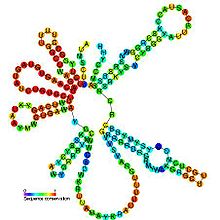| U2 spliceosomal RNA | |
|---|---|
 Predicted secondary structure and sequence conservation of U2 | |
| Identifiers | |
| Symbol | U2 |
| Rfam | RF00004 |
| Other data | |
| RNA type | Gene; snRNA; splicing |
| Domain(s) | Eukaryota |
| GO | GO:0000370 GO:0045131 GO:0005686 |
| SO | SO:0000392 |
| PDB structures | PDBe |
U2 spliceosomal snRNAs are a species of small nuclear RNA (snRNA) molecules found in the major spliceosomal (Sm) machinery of virtually all eukaryotic organisms. In vivo, U2 snRNA along with its associated polypeptides assemble to produce the U2 small nuclear ribonucleoprotein (snRNP), an essential component of the major spliceosomal complex.[1] The major spliceosomal-splicing pathway is occasionally referred to as U2 dependent, based on a class of Sm intron—found in mRNA primary transcripts—that are recognized exclusively by the U2 snRNP during early stages of spliceosomal assembly.[2] In addition to U2 dependent intron recognition, U2 snRNA has been theorized to serve a catalytic role in the chemistry of pre-RNA splicing as well.[3][4] Similar to ribosomal RNAs (rRNAs), Sm snRNAs must mediate both RNA:RNA and RNA:protein contacts and hence have evolved specialized, highly conserved, primary and secondary structural elements to facilitate these types of interactions.[5][6]
Shortly after the discovery that mRNA primary transcripts contain long, non-coding intervening sequences (introns) by Sharp and Roberts,[7][8] Joan Steitz began work to characterize the biochemical mechanism of intron excision.[9] The curious observation that a sequence found in the 5´ region of the U1 snRNA exhibited extensive base pairing complementarity with conserved sequences across 5´ splice junctions in hnRNA transcripts prompted speculation that certain snRNAs may be involved in recognizing splice site boundaries through RNA:RNA contacts.[9] Only recently have atomic crystal structures revealed demonstrably that the original conjecture was indeed correct, even if the complexity of these interactions were not fully realized at the time.[5][6][10]
- ^ Alberts B, Johnson A, Lewis J, Raff M, Roberts K, Walter P (2002). Molecular Biology of the Cell (4th ed.). Garland Science. ISBN 978-0815332183.
- ^ Nelson DL, Cox MM, Lehninger AL (2013). Lehninger principles of biochemistry (6th ed.). New York: W.H. Freeman and Company. ISBN 9781429234146. OCLC 824794893.
- ^ Fica SM, Tuttle N, Novak T, Li NS, Lu J, Koodathingal P, Dai Q, Staley JP, Piccirilli JA (November 2013). "RNA catalyses nuclear pre-mRNA splicing". Nature. 503 (7475): 229–34. Bibcode:2013Natur.503..229F. doi:10.1038/nature12734. PMC 4666680. PMID 24196718.
- ^ Shi Y (August 2017). "The Spliceosome: A Protein-Directed Metalloribozyme". Journal of Molecular Biology. 429 (17): 2640–2653. doi:10.1016/j.jmb.2017.07.010. PMID 28733144.
- ^ a b Stallings, Sarah C; Moore, Peter B (1997). "The structure of an essential splicing element: stem loop IIa from yeast U2 snRNA". Structure. 5 (9): 1173–1185. doi:10.1016/s0969-2126(97)00268-2. ISSN 0969-2126. PMID 9331416.
- ^ a b Burke JE, Sashital DG, Zuo X, Wang YX, Butcher SE (April 2012). "Structure of the yeast U2/U6 snRNA complex". RNA. 18 (4): 673–83. doi:10.1261/rna.031138.111. PMC 3312555. PMID 22328579.
- ^ Berget SM, Moore C, Sharp PA (August 1977). "Spliced segments at the 5' terminus of adenovirus 2 late mRNA". Proceedings of the National Academy of Sciences of the United States of America. 74 (8): 3171–5. Bibcode:1977PNAS...74.3171B. doi:10.1073/pnas.74.8.3171. PMC 431482. PMID 269380.
- ^ Chow LT, Gelinas RE, Broker TR, Roberts RJ (September 1977). "An amazing sequence arrangement at the 5' ends of adenovirus 2 messenger RNA". Cell. 12 (1): 1–8. doi:10.1016/0092-8674(77)90180-5. PMID 902310. S2CID 2099968.
- ^ a b Lerner MR, Boyle JA, Mount SM, Wolin SL, Steitz JA (January 1980). "Are snRNPs involved in splicing?". Nature. 283 (5743): 220–4. Bibcode:1980Natur.283..220L. doi:10.1038/283220a0. PMID 7350545. S2CID 4266714.
- ^ Perriman R, Ares M (May 2010). "Invariant U2 snRNA nucleotides form a stem loop to recognize the intron early in splicing". Molecular Cell. 38 (3): 416–27. doi:10.1016/j.molcel.2010.02.036. PMC 2872779. PMID 20471947.